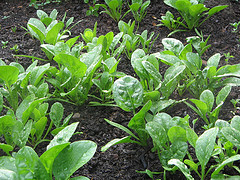Spinach
| Infobox on Spinach | |
|---|---|
| Example of Spinach |  |
| Freshness facts | |
| Optimum carrying temperature | 0°C |
| Highest freezing point | - |
| Acceptable product temp. at loading into containers | Max. 2°C above carrying temperature |
| Optimum humidity | 95% to 98% |
| Ventilation setting for containers | 25 m³/hr |
| Storage life | 1 to 2 weeks |
| Climacteric / non-climacteric | Non-climacteric |
| Ethylene production | Very low |
| Ethylene sensitivity | High |
| Modified / controlled atmosphere | 7% to 10% O2; 5% to 10% CO2 |
| Potential benefits | Slight |
| Availability | |
| On demand | |
Spinach
Contents
Harvesting and Handling
Spinach is selected for size and maximal recovery of clean leaves that are mid-maturity to young. Older and yellowing leaves are avoided when making the harvest cut. Generally 3-4 weeks of re-growth are required before a second harvest will yield adequate volume.
Spinach, whether bunched or as leaves, should be uniformly green (generally not yellow-green), fully turgid, fairly clean, and free from serious damage. For bunched spinach, roots should be trimmed short to grade standards and petioles should be predominantly shorter than the leaf blade. Most spinach for fresh market is pre-packaged in perforated plastic bags to reduce moisture loss and physical injury.
Cooling and Storage
Spinach is highly perishable and will not maintain good quality for more than 2 weeks at 0°C and 95% to 98% RH. Wilting, yellowing of leaves, and decay are likely to increase following storage beyond 10-14 days; faster at common distribution conditions of 5 to10°C.
Freezing injury will be initiated at - 0.3°C. Freezing injury results in water-soaking typically followed by rapid decay by soft-rot bacteria.
Controlled atmosphere considerations
Atmospheres of 7-10% O2 and 5-10% CO2 offer moderate benefit to spinach by delaying yellowing. Spinach is tolerant to higher CO2 concentration but no increase in benefits has been observed. Package film for pre-washed spinach leaves is selected to maintain 1-3% O2 and 8-10% CO2 .
Spinach is highly sensitive to exogenous ethylene. Accelerated yellowing will result from low levels of ethylene during distribution and short-term storage. Do not mix loads such as apples, melons and tomatoes with spinach.
Storage disorders
Anthracnose, Bacterial soft rot, Downy mildew.











